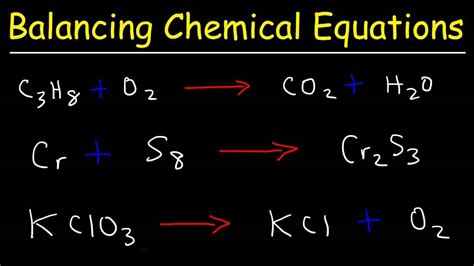How to Balance Chemical Reactions: A Step-by-Step Guide
Balancing chemical reactions is a fundamental skill in chemistry. It's crucial because it reflects the law of conservation of mass, which states that matter cannot be created or destroyed in a chemical reaction. This means the number of atoms of each element must be the same on both the reactant (left) and product (right) sides of the equation. This guide will walk you through the process, explaining different methods and providing practical examples.
Understanding Chemical Equations
Before we dive into balancing, let's review the basics. A chemical equation represents a chemical reaction using chemical formulas. For instance:
H₂ + O₂ → H₂O
This equation represents the reaction between hydrogen (H₂) and oxygen (O₂) to produce water (H₂O). However, it's unbalanced because the number of oxygen atoms differs on each side. Balancing ensures we have an equal number of each atom type.
Methods for Balancing Chemical Equations
Several methods exist for balancing chemical equations. We'll cover two common and effective approaches:
1. The Inspection Method (Trial and Error)
This is a straightforward method, especially useful for simpler equations. It involves adjusting the coefficients (numbers in front of the chemical formulas) until the number of atoms of each element is the same on both sides.
Steps:
- Start with the most complex molecule: Identify the molecule with the most atoms and start balancing its elements.
- Balance one element at a time: Adjust coefficients to balance the number of atoms of one element, then move to the next.
- Continue until all elements are balanced: Repeat steps 1 and 2 until the number of atoms of each element is equal on both sides.
- Check your work: Verify that all elements are balanced.
Example: Balance the equation: Fe + O₂ → Fe₂O₃
- Start with Fe₂O₃: There are 2 iron (Fe) atoms and 3 oxygen (O) atoms.
- Balance Fe: Add a coefficient of 2 to Fe on the reactant side: 2Fe + O₂ → Fe₂O₃.
- Balance O: There are 2 oxygen atoms on the left and 3 on the right. To balance, use fractional coefficients: 2Fe + (3/2)O₂ → Fe₂O₃.
- Remove fractions (if any): Multiply all coefficients by 2 to eliminate the fraction: 4Fe + 3O₂ → 2Fe₂O₃.
Now the equation is balanced.
2. The Algebraic Method
This method is more systematic and helpful for complex equations. It involves assigning variables to the coefficients and solving a system of equations.
Steps:
- Assign variables to coefficients: Assign variables (e.g., a, b, c) to the coefficients of each molecule.
- Set up equations: Write equations based on the number of atoms of each element, ensuring equality on both sides.
- Solve the system of equations: Solve the equations simultaneously to find the values of the variables.
- Substitute values: Substitute the values of the variables back into the original equation to get the balanced equation.
Example: Balance the equation: C₃H₈ + O₂ → CO₂ + H₂O
- Assign variables: aC₃H₈ + bO₂ → cCO₂ + dH₂O
- Set up equations:
- Carbon (C): 3a = c
- Hydrogen (H): 8a = 2d
- Oxygen (O): 2b = 2c + d
- Solve: Choose a value for one variable (e.g., a=1). Then solve for the others. You'll find c=3, d=4, b=5.
- Substitute: C₃H₈ + 5O₂ → 3CO₂ + 4H₂O
Tips for Success
- Practice regularly: The more you practice, the better you'll become at balancing equations.
- Start with simpler equations: Build your confidence by starting with easier examples before tackling more complex ones.
- Use a systematic approach: Following a consistent method, like the inspection or algebraic method, will help you avoid errors.
- Double-check your work: Always verify that your balanced equation has an equal number of each type of atom on both sides.
Mastering the art of balancing chemical equations is essential for anyone studying chemistry. By understanding the underlying principles and employing the methods described above, you'll be well-equipped to tackle even the most challenging equations.
